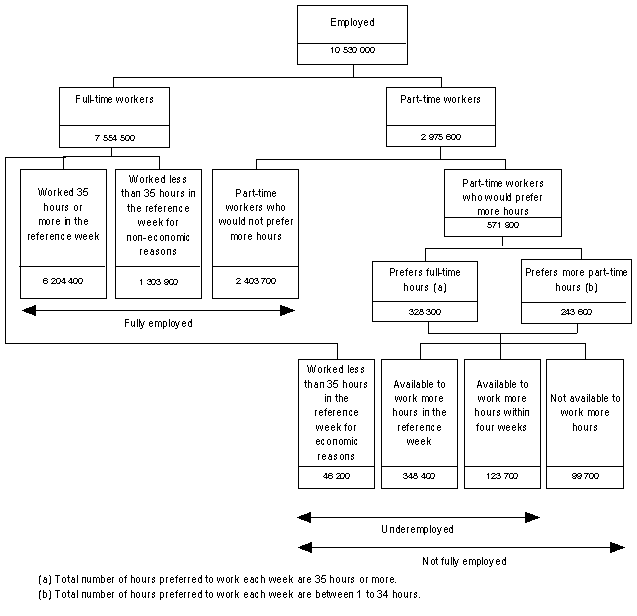CONCEPTUAL FRAMEWORK
CONCEPTUAL FRAMEWORK
The ABS conceptual framework for underemployment separates employed people into two mutually exclusive groups:
- workers who are fully employed, comprising:
- employed people who worked full-time during the reference week (includes people who usually work part-time)
- employed people who usually work full-time but worked part-time in the reference week for non-economic reasons (including illness or injury, leave, holiday or flextime, and personal reasons)
- part-time workers (usually work part-time and did so in the reference week) who would not prefer additional hours of work.
- workers who are not fully employed, comprising:
- part-time workers who would prefer to work more hours
- full-time workers who worked part-time in the reference week for economic reasons (such as being stood down or insufficient work being available).

The ABS underemployment framework classifies people who are not fully employed into a number of groups. The framework separately identifies part-time workers who would prefer full-time hours and those who would prefer more part-time hours. These people are further classified according to whether they were available to start extra work (either in the reference week or in the four weeks subsequent to the survey).
People who usually work full-time, but worked part-time in the reference week for economic reasons, are separately identified in the underemployment framework. It is assumed that these people would prefer to work full-time in the reference week and would have been available to do so.
DEFINITION OF UNDEREMPLOYMENT
The ABS definition of underemployment is consistent with the International Labour Organisation (ILO) definition of time-related underemployment adopted in 1998. According to this definition, time-related underemployment exists when the hours of work of an employed person are below a threshold, and are insufficient in relation to an alternative employment situation in which the person is willing and available to engage. More specifically, people in time-related underemployment comprise all employed people (as defined) who satisfy the following three criteria:
- willingness to work additional hours - want to work more hours than they currently work. The ILO recommends that those who have actively sought to work additional hours should be distinguished from those who have not
- availability to work additional hours, within a specified subsequent period
- worked less than a threshold (determined according to national circumstances) relating to working time - the ABS underemployment framework uses a threshold (35 hours in the reference week) based on the boundary between full-time and part-time work.
UNDEREMPLOYED WORKERS SURVEY
The Underemployed Workers Survey is the primary ABS data source on underemployment. It provides a wide range of information about underemployed workers, including information on the number of hours usually worked, number of preferred hours, steps taken to find work with more hours, and difficulties finding work with more hours. Summary information on underemployed workers is also collected in the Labour Force Survey (LFS) on a quarterly basis.
 Print Page
Print Page
 Print All
Print All
 Quality Declaration
Quality Declaration